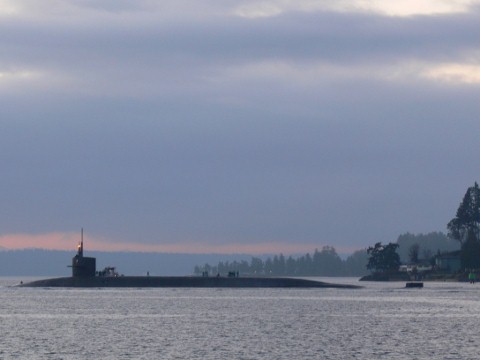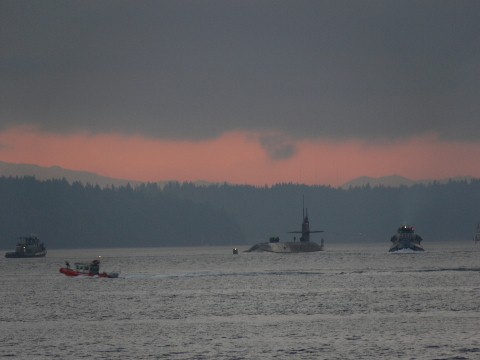
Lynwood Center, tucked into the corner at the west end of Rich Passage, has become one of our close-to-home favorites. It’s nearness to the ferry routes and other traffic in Rich Passage make it an unusual anchorage. When we first stopped there, we expected that ferry wakes in particular would toss the boat a fair bit, but the anchorage is surprisingly calm (we surmise through a combination of the ferries slowing to take the corner and their east-west wake cancelling out the north-south wake.)
Diving birds provide constant entertainment, and on clear days the anchorage has a great view to Mount Rainier, but we especially enjoy watching the traffic through Rich Passage. Most memorable was a navy submarine that passed through from Bremerton with an impressive escort of two Coast Guard cutters, three high-speed Coast Guard RIBs and two large Navy tugs.
 |
 |
Public shore access is close by at the Schel-chelb Estuary, owned by the Bainbridge Island Parks and Recreation District. You can land there and walk a short distance to Lynwood Center. We stopped once at the bright and airy Treehouse Café for an excellent thin-crust pizza with a microbrew on tap. Lynwood Center also has a small grocery store, a movie theatre and a couple of other restaurants. Returning, we discovered that the tide comes in a long way. James had to wade out in his jeans, in cold winter weather, to rescue our stranded dinghy.
 |
 |
 |
Last weekend we anchored there in the new boat for the first time. We had expected the 52 to roll significantly more than the hard-chined 4087 when a wake did come through, but so far we’ve been pleasantly surprised.
Anchoring notes: Anchor in 3-4 fathoms in the bight along the north shore at the west end of Rich Passage. North and southeast wind protection is good, but southwest winds blowing across Port Orchard can force substantial waves into Rich Passage. The Schel-chelb Estuary (see http://www.ci.bainbridge-isl.wa.us/shoreline_access_guidebook.aspx) is at the north corner where the road passes over a culvert.
That sounds like a great system John. Thanks for passing it along.
–jrh
jrh@mvdirona.com
While not a yacht owner (yet), I have some good experience in securing my families 14 foot Glasspar runabout on various shores around the area from Blake Island to Hood Canal, etc. The tides DO move a lot around the Sound and having to swim for your boat or try to push it off a sandy shore isn’t much fun. Last year we camped on Blake Island and there was a +10 high going into a -2. It was amazing how much the water rose and then fell away! During this tidal change, our run about, the Jammie Dodger, was floating happily and I didn’t have to go swimming to retrieve her. How did I do it….?
I keep a regular 10 pound Danforth anchor on board with 100′ of line and 10 feet of chain. (This is stored in a backpack to keep it from making a mess while we are playing). I also keep a 10 pound drag anchor (little half cone thing)with about 30 feet of line. When we come to shore just about anywhere, we get both ready. As we approach the shore, my 1st mate will tie the end of the drag anchor off on a cleat and then drop it off the stern when we are within 50 feet or so of shore. It may drag a bit but thats no biggie. The important part is to make sure there is plenty of line to play out behind the boat. Once ashore, everyone hops off the bow while I set the Danforth. Take all the line out and run the anchor up the shore past the high tide line. Once everyone is off the boat, I just give her a shove and out she goes. If the tide is coming in, the drag anchor prevents her from hopping up the shore and getting stuck in the sand, rocks, etc. If the tide is going out, the 100 foot of line is plenty for most beaches to keep her from floating away, and there should be enough play on your drag line for the boat to move out with the water. When you are ready to go, just start pulling the anchor line to bring your boat in. The cone shape of the anchor will not hook on anything as it has no edges and will just slide up the beach. Once you get the bow of your boat to you, load up your anchor, untie the drag and stow it and give a shove. Away you go! Dry and ready for a new adventure.
I tried finding an image of the drag anchor but didn’t have much luck. What I use is similar to a mushroom anchor like this one (which would probably work) but its more like a cone with the tip chopped off.
http://www.sportsmansguide.com/zoom/zoompop.asp?i=169895_ts.JPG&h=&w=&bgc=&ui=&mc=&cf=&nv=&c=&adid=559797
Yes, we love exploring by dinghy. And, yes, you’re right the challenge in areas with large tidal exchanges is to be able to land without wading in and yet not have the dinghy stranded on shore by falling tide or only reachable by wading. We try to land in areas with a steep shore to avoid this problem but, as you note, this isn’t always possible and we have humorous pictures of me wading a couple of hundred feet off shore in 45F water to recover the boat. And others of us having to drag it down beaches.
With the old 9′ dinghy with an 8HP 2-stroke outboard, we actually could drag it. With the new one, that’s really no longer possible. It’s over 700 lbs so we need to avoid the problem now. We use an anchor buddy http://tuggyproducts.com/anchorbuddy.html) from Tuggy products. Using this device, you drop anchor offshore, pull to shore, land and then release the dinghy to be pulled back out by the spring force of the Anchor Buddy. We still aim for steep beaches but, when we can’t find one, we use the Anchor Buddy.
Thanks for the great writeup on Rich Passage and Lynwood Center, this destination is on my list now.
I always enjoy your blog posts that involve dinghy landings — it’s those kinds of destinations that inspired me to get a dinghy. It looks like you’ve landed at beaches all over the Sound, even in areas with big tidal variation. I’d love to hear more about the technical aspects of beaching or mooring off of beaches with a dinghy. I haven’t yet tried any beach landings in our dinghy (13′ Boston Whaler) in the Sound, mostly because I don’t know how to secure it for a couple hours without having to drag it way up the beach or go wading for it. Given the picture of James in this post, maybe that’s unavoidable. :)
So, if you have any experiences, techniques or suggestions you’d like to share, I’d love to read ’em. Thanks, and also a big thanks for all the great information on blog.mvdirona.com, it’s a great read!
–Stuart